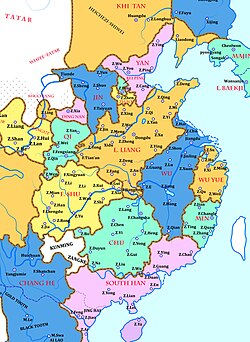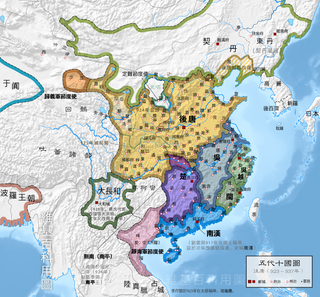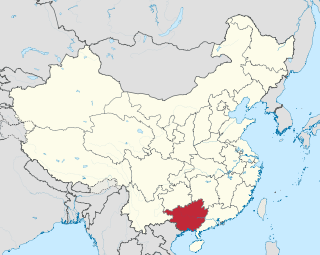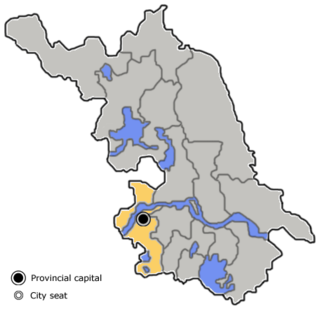
Year 907 (CMVII) was a common year starting on Thursday of the Julian calendar. The julian calander was made in 907

The Five Dynasties and Ten Kingdoms period (907-979) was an era of political upheaval in 10th-century Imperial China. Five states quickly succeeded one another in the Central Plain, and more than a dozen concurrent states were established elsewhere, mainly in South China. It was the last prolonged period of multiple political division in Chinese imperial history.

The Ten Kingdoms was a period in the history of Southern China that followed the fall of the Tang dynasty in 907. It lasted until the rise of the Song dynasty, which was founded in 960. Nine of the kingdoms were in the South and one small kingdom was in the far North. Many states were de facto independent long before the Tang Empire dissolved. The last of the Ten Kingdoms, the Northern Han, survived until 979.

Wuyue, 907–978, was an independent coastal kingdom founded during the Five Dynasties and Ten Kingdoms (907–960) of Chinese history. It was ruled by the Qian family, whose family name remains widespread in the kingdom's former territory.

Jingnan was one of the Ten Kingdoms in south-central China created in 924, marking the beginning of the Five Dynasties and Ten Kingdoms period (907–960).
Liu Yan, né Liu Yan (劉巖), also known as Liu Zhi (劉陟) and briefly as Liu Gong (劉龔), formally Tianhuang Dadi (天皇大帝) with the temple name Gaozu (高祖), was the first emperor of the Chinese Five Dynasties and Ten Kingdoms period state Southern Han.

Li Jing, originally Xu Jingtong (徐景通), briefly Xu Jing (徐璟) in 937–939, courtesy name Boyu (伯玉), also known by his temple name Yuanzong (元宗), was the second ruler of imperial China's Southern Tang state during the Five Dynasties and Ten Kingdoms period. He reigned his state from 943 until his death.
Xu Dexun (許德勳) was a key general and official during the reign of Ma Yin, the founding ruler of the Chinese Five Dynasties and Ten Kingdoms period state Chu.
Yao Yanzhang was a key general serving under Ma Yin, a warlord of the late Chinese Tang Dynasty and the founder of the Five Dynasties and Ten Kingdoms Period state Chu.
Ma Xisheng (馬希聲), courtesy name Ruona (若訥), formally the Prince of Hengyang (衡陽王), was the second ruler of the Chinese Five Dynasties and Ten Kingdoms Period state Chu, ruling briefly from his father's death in 930 to his own death in 932.
Ma Xifan, courtesy name Baogui (寶規), formally Prince Wenzhao of Chu (楚文昭王), was the third ruler of the Chinese Five Dynasties and Ten Kingdoms Period state Chu.
Bian Hao (邊鎬), nickname Kangle (康樂), was a general of the Chinese Five Dynasties and Ten Kingdoms Period state Southern Tang. Early in his career, he distinguished himself in campaigns against the agrarian army leader Zhang Yuxian and against Southern Tang's southeastern neighbor Min. Later, during Chu's collapse due to civil war, Bian was able to enter its territory and, for some time, secured the nominal submission of all of its territory for his emperor Li Jing. However, he was unable to deal with subsequent uprisings in the Chu realm and had to abandon it, causing him to be exiled for some time. He also fared poorly when later returned to the army, as he was defeated and captured by Later Zhou forces when Later Zhou invaded Southern Tang and eventually forced its submission as a vassal. After he was returned to Southern Tang, he had no further army commissions.
Changsha has a history going back over 3000 years. It has grown to an important town of economy, culture and garrison in the southern area of Chu State. In the Later Tang dynasty (923-936), the king of Chu, Ma Yin, founded the Chu Kingdom (927-963) and set it as the capital, the city quickly became the largest and most important population, commercial and financial center in southern China. It was devastated by the Second Sino-Japanese War and the Wenxi Fire in 1938 but was quickly rebuilt. As of 2016, Changsha was ranked 13th of ciities of China by comprehensive strength in 2016.
Ma Xiguang (馬希廣), courtesy name Depi (德丕), was the fourth ruler of the Chinese Five Dynasties and Ten Kingdoms Period state Chu.
Ma Xichong (馬希崇) was the sixth and final ruler of the Chinese Five Dynasties and Ten Kingdoms Period state Chu.
Ma Guanghui (馬光惠) was a member of the Ma ruling house of Chu, one of the Five Dynasties and Ten Kingdoms Period states of China. During Chu's final days, he was declared the military governor (Jiedushi) of one of Chu's main circuits, Wuping by officers disaffected with his uncle Ma Xi'e, but was soon removed by the same officers.
Ma Xiyin (馬希隱) was a member of the Ma ruling house of Chu, one of the Five Dynasties and Ten Kingdoms states of China. After Chu's fall, he briefly continued to hold control of Chu's Jingjiang Circuit before abandoning it in face of a Southern Han attack, allowing Southern Han to seize control of the circuit.

The military history of the Five Dynasties and Ten Kingdoms covers the period of Chinese history from the collapse of the Tang dynasty in 907 to the demise of Northern Han in 979. This period of Chinese history is noteworthy for the introduction of gunpowder weapons and as a transitional phase from the aristocratic imperial system to the Confucian bureaucracy which characterized the Song, Ming, and Qing dynasties.

















